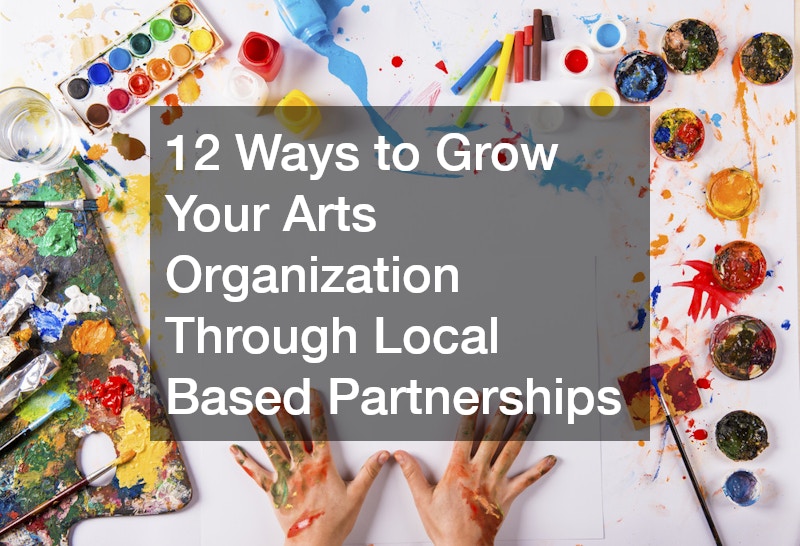
In today’s competitive cultural landscape, arts organizations must do more than put on great performances or display beautiful works of art—they must also become integral parts of their local communities. The most sustainable and impactful way to do this is through local based partnerships. Collaborating with nearby businesses, service providers, and community organizations creates mutual benefits: increased visibility, deeper community engagement, shared resources, and diversified funding streams.
Forging connections locally not only helps your arts organization grow, but also builds lasting goodwill. Whether you’re a theater group, a gallery, a dance troupe, or a community arts nonprofit, local collaboration puts your mission in front of people who are already invested in the well-being of your region. These local based connections offer both promotional power and logistical support, allowing you to reach more audiences while sharing costs and responsibilities.
In this blog, we’ll walk through 12 actionable and strategic ways to grow your arts organization through partnerships that are close to home. Each section will focus on a specific type of partnership—from working with a local gold buyer to a local HVAC company—and demonstrate how these connections can enhance your reach, programming, and sustainability. Along the way, we’ll also explore some partnerships that offer indirect benefits, such as brand association, event co-hosting, and community trust-building.
Let’s explore how your arts organization can thrive through meaningful, local based alliances.
1. Work Together to Support Fundraisers

One often overlooked yet creative opportunity for collaboration is with a local gold buyer. These businesses often have a well-established clientele and community trust—an asset that arts organizations can benefit from. Consider hosting a jewelry appraisal night at your venue or organizing a gold-donation drive where community members contribute unused gold to be converted into funding for your programs.
This type of event can draw foot traffic from demographics that may not typically attend the arts, introducing them to your work while engaging them in a cause. The local gold buyer benefits from increased exposure and goodwill, while you gain a unique fundraising angle. Positioning this as a local based initiative highlights your investment in your immediate economy and enhances your reputation for community innovation.
Such partnerships can also lead to sponsorship opportunities, with the buyer offering prizes, underwriting events, or even becoming a long-term donor. This blend of financial support and co-marketing can help elevate your fundraising strategy to a whole new level.
2. Co-Promote Events with a Local
When planning seasonal performances or gallery openings, comfort is key—especially in regions with extreme weather. Partnering with a local HVAC company ensures your facilities remain climate-controlled, which in turn helps preserve art and keeps guests comfortable.
Beyond infrastructure, this type of partnership can also extend to co-branded content. For example, run a social media series on “cool performances for hot nights” or “warm up with the arts this winter,” featuring HVAC tips alongside your event promotions. This strategy reinforces both brands’ relevance while rooting the initiative in a local based narrative.
Furthermore, HVAC companies often serve both residential and commercial clients, giving your events exposure to an even wider network of homeowners and business owners. These companies may also be interested in sponsoring community nights or offering rebates for patrons who attend your events.
By embedding your brand within a local based business network, you’re not only tapping into logistical expertise—you’re aligning your arts organization with the everyday needs and values of your community.
3. Collaborate for Cross-Promotions
Food and the arts go hand-in-hand, making a local pizza shop a natural partner for collaborative promotions. Offering a “show your ticket, get a discount” deal creates a mutually beneficial arrangement: your patrons enjoy a meal out, while the restaurant benefits from increased foot traffic.
Take it a step further by co-creating limited-time menu items themed after your latest production or exhibit. A Shakespeare play could inspire “The Romeo and Julienne,” while an abstract art show could feature a colorful veggie pizza. Cross-promotion through posters, social media shoutouts, and email newsletters can drive engagement across both audiences.
This kind of local based marketing creates shared value. The arts become more accessible and tied to a full-night-out experience, while the restaurant gains loyal customers from your following.
In addition, hosting pop-up performances or live music at the pizza shop can serve as a way to preview upcoming events and expand your community reach beyond your venue.
4. Work with Catering for Cultural Events

Hosting a cultural festival or community open house? A catering business can do more than just serve food—they can help create a themed experience that enhances your programming. Whether it’s cuisine from a specific culture or artisanal fare that complements your exhibit, this collaboration adds richness and relevance to your events.
You can also consider joint events, such as “tasting and theatre” nights or gallery dinners, where the culinary experience is as curated as the art on display. These immersive experiences help attract new audiences and elevate the perceived value of your programs.
Promoting your partnership as a local based initiative supports other small businesses while diversifying your revenue. Caterers may even offer in-kind support for nonprofit galas or contribute a portion of proceeds from joint ticketed events.
These partnerships work best when there’s a shared aesthetic or mission—so seek out caterers who value community engagement, sustainability, or multiculturalism to align with your organization’s goals.
5. Partner for VIP Packages
Offering a luxury experience can help boost attendance and attract new patrons. By partnering with a local limousine company, you can create VIP ticket packages that include door-to-door service, pre-show receptions, and meet-the-artist opportunities.
This partnership adds an air of sophistication and makes your arts event feel exclusive and memorable. It also appeals to corporate groups or donors looking for a unique night out. The local limousine company benefits from exposure to a clientele that values premium services.
Promote these experiences as part of a local based cultural luxury—combining high-end transportation with community arts. This can encourage participation from audiences who might not otherwise engage with your programming.
Additionally, limousine companies often have relationships with hotels and event venues, offering a new avenue for multi-party collaborations that could lead to destination event packages or tourist promotions.
6. Highlight Partnerships Through Media Campaigns
Not all collaborations need a direct service exchange. Sometimes the most powerful thing you can do is tell the story of your local based partnerships through dedicated media campaigns.
Document your collaborations via blog posts, behind-the-scenes videos, or spotlight interviews with your partners. Highlight how the arts and local businesses support one another, and show the real faces behind each organization.
These narratives deepen community ties and encourage reciprocal support. Local media outlets may also be more inclined to cover your events when they involve other businesses or sectors, expanding your visibility.
Such storytelling reinforces your identity as a community-centered arts organization, opening doors to new patrons, grants, and strategic relationships.
7. Collaborate to Improve Venue Safety

Keeping your performance or exhibit space well-lit and safe is a top priority. Partnering with a local electrician ensures that your technical needs—from stage lighting to emergency exits—are met professionally and efficiently.
In addition to on-site services, electricians can help with energy audits or installations of eco-friendly lighting systems, aligning your venue with sustainability goals. Promoting this as a local based effort helps position your organization as both environmentally and community conscious.
You might even explore sponsorship or barter arrangements, such as offering complimentary tickets in exchange for services, or featuring their logo on event banners. These arrangements build long-term trust and can help reduce operational costs.
Moreover, electricians often work on new construction or renovation projects, which could lead to introductions to contractors, architects, or developers who may have an interest in supporting or showcasing the arts.
8. Support with Private Performances
Connecting with the Senior Living community offers a deeply meaningful avenue for engagement. Organize private performances, gallery tours, or art workshops that cater specifically to seniors, especially those with limited mobility.
These events not only uplift residents but also create strong community goodwill. Facilities may welcome partnerships that add cultural enrichment to their programming. Market these as local based cultural outreach initiatives that reflect your mission.
Senior Living centers also host regular events and often have dedicated newsletters or social media platforms where your organization can gain additional exposure.
Creating art access for older adults is not only compassionate—it’s strategic. It establishes your organization as inclusive and community-focused, which can strengthen your case for grant funding and local sponsorships.
9. Collaborate for Wellness Events
Health and wellness have become core themes in many communities, making local health food stores ideal partners. Host events that blend mindfulness and creativity, such as yoga and painting sessions, healthy cooking demos followed by poetry readings, or workshops on food and culture.
These collaborations highlight how the arts contribute to overall well-being. Cross-promotion with local based health brands can also expose your organization to audiences interested in holistic living.
Health food stores often have strong marketing platforms and loyal customer bases. They may be interested in sponsoring events, providing in-kind support, or featuring your programming in their locations.
These partnerships demonstrate your commitment to both individual and community wellness, aligning with broader public health and engagement goals.
10. Use Local Based Community Boards
Many neighborhoods hav e local based community boards or associations that offer resources, venues, or promotional platforms for arts programming. Engage with these groups to co-host events, apply for micro-grants, or access shared spaces.
e local based community boards or associations that offer resources, venues, or promotional platforms for arts programming. Engage with these groups to co-host events, apply for micro-grants, or access shared spaces.
These collaborations often come with built-in audiences and localized networks, helping your organization root itself more deeply in specific communities.
Being active in neighborhood associations also gives you a say in local development and can help shape future infrastructure to support the arts—such as new venues, signage, or public art installations.
Keep the relationship reciprocal by offering free performances, community tickets, or arts education programs.
11. Partner with a Handyman
A well-maintained venue enhances audience experience and reduces safety risks. Working with a local handyman ensures that small repairs don’t become big issues.
From hanging signage to fixing door locks, a reliable partner can help keep your space welcoming and functional. Promote this as part of your local based operational strategy.
Handymen also tend to be well-networked, and satisfied clients often refer others. This grassroots connectivity can lead to unexpected collaborations and increased word-of-mouth promotion.
Consider acknowledging your handyman in your program materials or website to build goodwill and encourage community trust.
12. Team Up for Themed Events and Galas
One of the most exciting ways to build a partnership is by collaborating with a local tuxedo rental company for themed events or galas. If your organization hosts formal nights, awards shows, or period-specific performances, tuxedo shops can provide in-kind support or promotional discounts.
This relationship turns preparation for an event into a community affair. Patrons picking up formalwear may become aware of your programs through in-store flyers or special ticket offers.
Frame the event as a local based celebration of culture and style. You can even host joint photo shoots, fashion previews, or fundraising campaigns that tie into both your missions. This type of alliance boosts your visibility in the lifestyle and event-planning sectors.
Moreover, tuxedo rentals often work with wedding planners, florists, and venue managers—opening doors to a web of potential partnerships you can leverage for future events.
By merging artistic flair with fashion and festivity, you create a memorable, multi-sensory experience that brings the community together in style.
Growing your arts organization doesn’t always require massive budgets or national campaigns—sometimes the most effective path is through meaningful, local based connections. Each partnership explored in this blog demonstrates how aligning with local businesses and service providers can yield tangible benefits: increased visibility, shared resources, and deeper community trust.
By working with businesses as diverse as a local pizza shop, a local handyman, or a local tuxedo rental service, your organization becomes an active participant in the community ecosystem. These relationships enhance your credibility, expand your reach, and often bring in new sources of revenue or support.
Moreover, storytelling around these collaborations—particularly those with a strong local based focus—can attract media attention, foster grant opportunities, and solidify your place as a vital cultural hub.
As you continue to build your audience and mission, remember that your neighbors are your greatest allies. The partnerships you forge today will shape the community impact you create tomorrow. Through smart, sincere collaborations, your arts organization can grow not just in numbers, but in purpose, connection, and sustainability.


